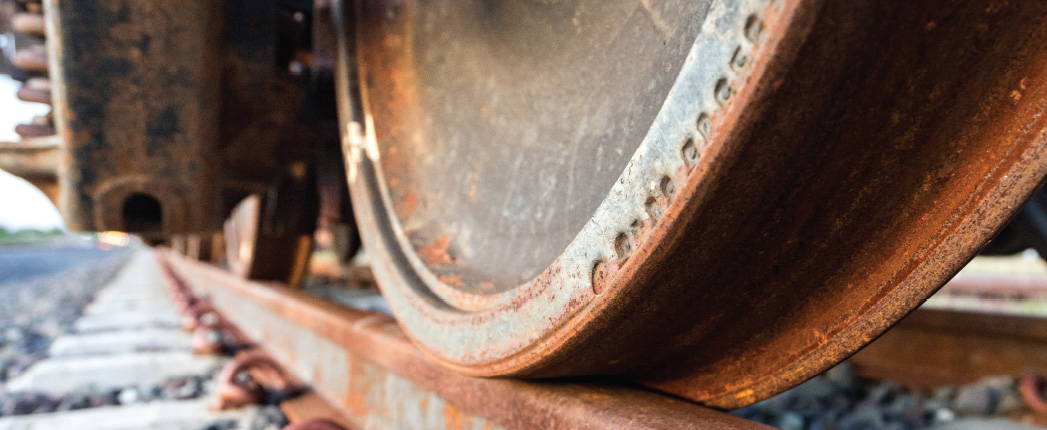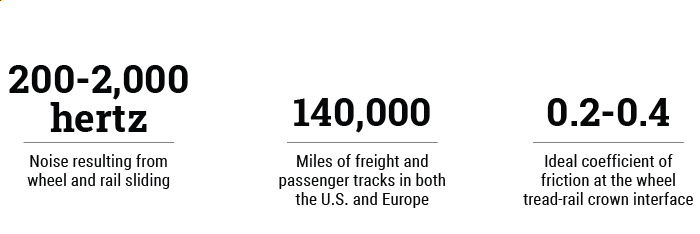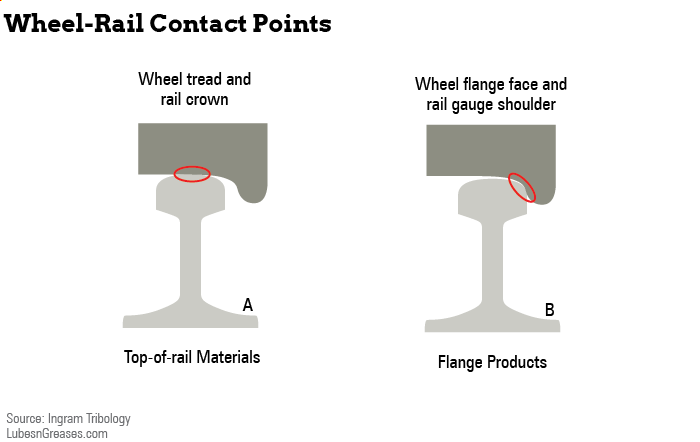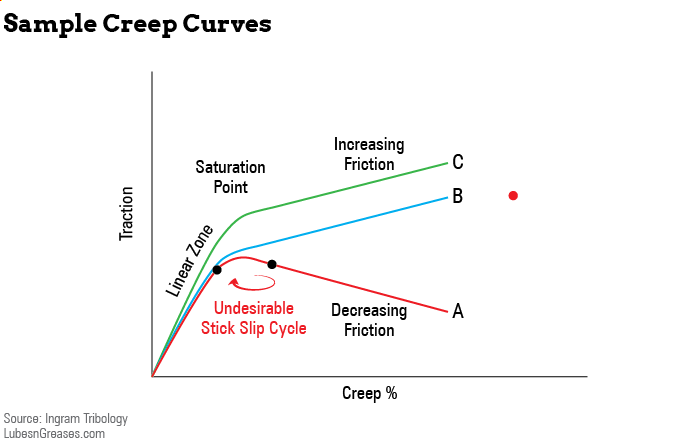
There are over 140,000 miles of freight and passenger railroad tracks in both the United States and Europe. As train wheels spin, move and grind to a halt on these tracks, railway greases work to control friction, reduce wear and silence noise, keeping a vital mode of transportation running smoothly.
Lubricating railways requires two different products because there are two different points of contact between a wheel and a railway, and each point presents a different level of friction. The point of contact where the wheel tread of the train and the rail crown meet require what are called top-of-rail materials. The wheel flange—or the part of the wheel that protrudes outward—and the shoulder of the rail require flange products. Both products serve a distinct purpose.
Top-of-rail materials are designed to hit a sweet spot of traction. At the wheel tread and rail crown interface, “you want high traction, so when the wheels turn the train moves forward and there’s no slipping. You don’t damage the rail,” Marc Ingram, consultant at Ingram Tribology in the United Kingdom, said during the European Lubricating Grease Institute’s Grease Symposium on April 26. “Also, of course, when you apply the brakes you want the train to stop in a controlled manner.”

At the same time, friction should not be too high, as it can damage the expensive rails. “You need to control the friction within a certain band—between about 0.2 and 0.4 in the friction coefficient,” he said.
Manufacturers of top-of-rail materials prefer to keep their formulations private, Ingram told Lubes’n’Greases. In Europe, water-based materials are most common, while more oil-based materials are used in North America. They also contain thickeners like clays, latex, silica and PVA styrene copolymers; solids like graphite, calcium carbonate and metal powders; and glycols.
The other point of contact, between the wheel flange and the shoulder of the rail, happens when a train goes around a corner. There, you want the friction to be as low as possible, said Ingram.

These flange products can be petroleum-based with mineral or synthetic base oils, and can use biodegradable oils for environmentally sensitive areas. Pavlo Solntsev, a laboratory manager at St. Paul, Minnesota-based Cortec, said that a fair amount of railway greases migrate from the rail to the ground.
Controlling friction and reducing wear aren’t the only jobs of railway greases. When a train goes around a curve, sliding occurs between the wheels and the rail, which makes a high-pitched noise from 200 to 2,000 hertz, according to Ingram.
“Unfortunately, these curves on railways are usually in urban centers. As a train approaches a city, it needs to go past houses and buildings,” Ingram explained. “That’s where a lot of noise is generated, and that’s where everyone lives.”
You can reduce that noise by controlling the friction characteristics where the wheel and rail meet, he continued. “To reduce noise, the friction should increase with the percentage creep.”
Creep is the lengthwise movement of the rails of the track in the direction of motion of locomotives. Starting the wheels pushes the rail backward, while braking pushes the rail forward. Creep curves help measure the performance of railway greases, particularly in reducing noise. “If you work in the lubricant industry, you may have seen traction curves, which are used to understand the traction properties of liquid lubricants,” said Ingram. “Essentially, it’s very similar.”
Creep can be determined using a formula: divide the sliding speed between the rail and the wheel—or the slip—by the speed of the train, and multiply by 100. When creep is 0, there is no sliding between the wheel and the rail, and the measured traction can be almost nothing.

“As you start to increase the percentage creep, as in you have a little bit of slip between the wheel and the rail, the center of that contact patch is rolling and the outer part is slipping,” said Ingram. “The more creep that is introduced, the more slippage and the more that contact patch becomes sliding until the entire contact patch is sliding.”
As creep increases, the contact becomes fully sliding, and a saturation point is reached. “This is where things get a little bit funny,” said Ingram. The friction can stay constant, increase or decrease depending on the friction characteristics of the grease.
If the friction decreases, the wheels can alternate between either side of the saturation point, creating noise, he said. “Ideally, what you want is once the saturation point is achieved, the friction continues to increase with the percentage slip. This is fully controllable by the chemistry of the top-of-rail materials or the flange products.”
Putting Railway Greases to the Test
Railway grease standards in Europe measure traction curves, friction coefficients and retention of the applied lubes, Mathias Woydt, managing director at Berlin-based Matrilub, said. Railhead lubrication “seems to be quite a simple tribosystem, but we have seen it’s not so easy to meet all these requirements,” he told attendees at the ELGI Grease Symposium.
One way to test these greases is with a twin disk machine. These rigs are usually custom made and feature two cylindrical disks mounted on rotating drive shafts that are pressed against each other. These disks have adjustable load, temperature, speed and slip settings. Grease is injected where the disks touch.
The twin disk test is required in European railway lube specifications EN 16028 and EN 15427, parts of which specify that the lubrication of the wheel-rail interface needs a set of defined coefficients of friction.
In tests using the twin disk machine, Woydt found that “the coefficients of friction or traction of grease lubricated contacts under slip-rolling ranged between the expected 0.06 and 0.1 friction.” It was also found that some railway greases offer “remarkably long” lubricity retention.
Most of the greases Woydt tested, including three flange products and one top-of-rail material, were composed of ester base oils. “Railway grease is a total loss lubricant by definition,” he explained. “Here, biodegradation and aquatic toxicity requirements apply.”
Ingram also had his hand in testing, helping to develop a new test method to evaluate railway greases. Ingram Tribology was approached by the Railway Safety and Standards Board, an independent non-profit company founded in 2003 to drive improvements in the safety and performance of the U.K.’s rail system. His company had experience with railway greases from developing a test method to evaluate flange products used in the London Underground transit system.
He and his team used PCS Instruments’ Mini Traction Machine, which measures frictional properties of lubricated and unlubricated contacts under a wide range of rolling and sliding conditions.
The rig uses an almost 20-millimeter steel ball and 46-mm steel disk. The ball is loaded against the face of the disk, and both are driven independently to create a rolling and sliding contact. The frictional force between the two is measured using a force transducer. The rig can get up to speeds of just over 13 feet per second.
“What makes it perfect for this work is it has very accurate control of those speeds,” explained Ingram. “So you can very accurately control the percentage slip in that contact, down to the 0.1% creep.”
The top-of-rail and flange products are applied to the disk, and the user can spin the ball alone, spin the disk alone, or spin both simultaneously. Ingram and his team 3D-printed masks with holes drilled in them and put them on the disk, applying the grease through the holes and onto the disk.
For the test, Total Lubricants provided four top-of-rail products, five flange products and one dual product—which can perform as both—with a second dual product provided by ProRail, a Dutch federal organization. All of the greases used are commercial products, and the testers were unaware of the commercial name of each product.
It took 11 iterations for the team to develop repeatable test conditions using the Mini Traction Machine. The 18-step method starts with three run-in steps. The first and third steps run at 100 mm per second for 15 minutes each, and the second step runs at 4,000 mm/s for one minute. “What that does is any kind of grease that isn’t settled is going to move,” said Ingram. “If that [second] step isn’t there, when you go to the creep curves later in the test, the grease can kind of move about, and that can affect your results.”
After that, a creep curve is generated at 1,000 mm/s—equal to a speed of 3.6 kilometers per hour—for about a minute. Then there is a pause where the ball and disk run at a speed of 50 mm/s for two minutes to cool the samples, followed by a creep curve generated at 3,800 mm/s—equal to a train speed of 13 km/h—for about a minute. This is followed by another pause. The process repeats until four creep curves at each speed are generated, but the first and last creep curve at each speed is not used for analysis.
The top-of-rail materials had higher traction compared to the flange materials, and most of the products had a positive gradient. “So you wouldn’t expect any noise from these products in the field, and all these products are approved for use in the field in Europe,” said Ingram. “So that makes sense that all these products are ‘good’ products. None of them have negative gradients and you would expect them to suppress noise.”
The samples mostly performed the same at the two speeds, but a few products showed higher friction characteristics at higher speeds.
A round robin study was conducted involving 12 different laboratories. The labs tested four samples that were included in Ingram’s tests: two top-of-rail materials, a flange product and a dual product. The testing found a wide range in traction coefficients for the two top-of-rail materials.
“The more I read about these materials, the more that this doesn’t concern me too much. Whenever these materials are measured on a twin disk machine or a real rail—they measure the traction on the rail using special tribometers—the values are very variable,” said Ingram. “I think that’s just the nature of these products. They’re very different from a normal lubricant that’s formulated to reduce friction.”
By comparison, the participating laboratories tended to have better reproducibility with the flange product throughout testing.
The method will be included in the upcoming top-of-rail material and flange product standards under the EN 15427 designation. It will be considered an indicative test—a test in the early stage of evaluating new candidate products for railways before full-scale testing is required for qualification.
Will Beverina is assistant editor for Lubes’n’Greases. Contact him at Will@LubesnGreases.com.